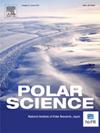Characterization of marine litter in the vicinity of the Machu Picchu Scientific Base, King George Island, Antarctica
IF 1.5
4区 地球科学
Q3 ECOLOGY
引用次数: 0
Abstract
In the present study, marine litter in the vicinity of the Machu Picchu Scientific Base, Antarctica, was quantified and characterized. A total of 33 items were counted, primarily composed of plastic debris and foams, followed by metallic structures. A high abundance of marine litter was associated with the proximity to the scientific base. Common plastic polymers were identified by Fourier-transformed infrared spectroscopy, including polypropylene, polyethylene, polyurethane, acrylates, and polystyrene. The abundance of synthetic polymer materials could potentially release toxic chemicals and microplastics into the environment. We suspect that permanent and seasonal Antarctic bases' maintenance and operation release large amounts of structural waste to their surroundings and lack proper solid waste management. For this reason, enforcing solid waste management systems and internal regulations is necessary to follow the guidelines of the Protocol on Environmental Protection to the Antarctic Treaty.
南极洲乔治王岛马丘比丘科学基地附近海洋垃圾的特征
本研究对南极洲马丘比丘科学基地附近的海洋垃圾进行了定量分析和表征。总共统计了33件物品,主要由塑料碎片和泡沫组成,其次是金属结构。大量的海洋垃圾与靠近科学基地有关。用傅里叶变换红外光谱法鉴定了常见的塑料聚合物,包括聚丙烯、聚乙烯、聚氨酯、丙烯酸酯和聚苯乙烯。大量的合成高分子材料可能会向环境中释放有毒化学物质和微塑料。我们怀疑,南极永久性和季节性基地的维护和运营向周边地区排放了大量的结构垃圾,并且缺乏适当的固体废物管理。因此,必须执行固体废物管理制度和内部条例,以遵循《南极条约关于环境保护的议定书》的准则。
本文章由计算机程序翻译,如有差异,请以英文原文为准。
求助全文
约1分钟内获得全文
求助全文
来源期刊

Polar Science
ECOLOGY-GEOSCIENCES, MULTIDISCIPLINARY
CiteScore
3.90
自引率
5.60%
发文量
46
期刊介绍:
Polar Science is an international, peer-reviewed quarterly journal. It is dedicated to publishing original research articles for sciences relating to the polar regions of the Earth and other planets. Polar Science aims to cover 15 disciplines which are listed below; they cover most aspects of physical sciences, geosciences and life sciences, together with engineering and social sciences. Articles should attract the interest of broad polar science communities, and not be limited to the interests of those who work under specific research subjects. Polar Science also has an Open Archive whereby published articles are made freely available from ScienceDirect after an embargo period of 24 months from the date of publication.
- Space and upper atmosphere physics
- Atmospheric science/climatology
- Glaciology
- Oceanography/sea ice studies
- Geology/petrology
- Solid earth geophysics/seismology
- Marine Earth science
- Geomorphology/Cenozoic-Quaternary geology
- Meteoritics
- Terrestrial biology
- Marine biology
- Animal ecology
- Environment
- Polar Engineering
- Humanities and social sciences.
 求助内容:
求助内容: 应助结果提醒方式:
应助结果提醒方式:


